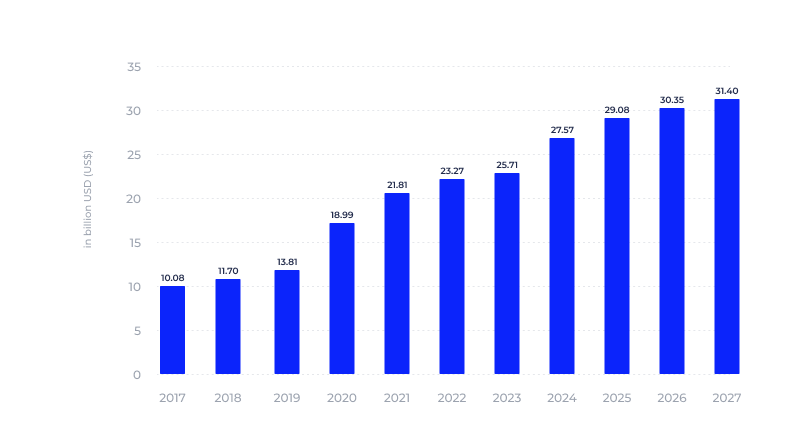Over 616.2 million music streaming subscribers were recorded in the second quarter of 2022, and the market volume is projected to reach $31 billion by 2027. People listen to their favorite songs on the go from anywhere in the world, and on multiple devices, leveraging on-demand access and modern technologies. As demand for streaming software soars, engineers face many challenges in developing a music streaming app that would meet everyone’s needs.

In this article, we explore the common challenges of music mobile app development for iOS. Our team covers major technical issues and other problems you might encounter on your journey. Read on now!
Technical Challenges in Developing an iOS Music Streaming App
We gathered the most frequent challenges with on-demand music app development that require careful consideration and planning. Making a mistake in these areas might lead to devastating losses, so let’s explore the potential solutions that could help you prevent these pitfalls.
1. Choosing the Right Technology Stack
One of the primary challenges in music mobile app development is selecting the appropriate tech stack. Your developers must decide between using Swift or Objective-C for native iOS apps and consider frameworks like Flutter or React Native for cross-platform solutions. Each option has its advantages and considerations.
Developing a native solution using Swift or Objective-C will provide a rich set of tools and help you access platform-specific features and APIs. These include:
- Native UI components: buttons, labels, sliders, and pickers that ensure your app aligns with the iOS design guidelines and provides a familiar user experience.
- Core APIs and frameworks: Core Data for data persistence, Core Animation for smooth animations and transitions, Core Location for location-based services, and Core Media for multimedia handling.
- Platform integration: SiriKit to enable voice commands, Apple Pay for in-app purchases, Apple Music for music streaming, and others.
- Security and privacy: Apple’s security guidelines include secure storage mechanisms, encryption algorithms, and best data handling practices.
By developing a native solution using Swift or Objective-C, you harness the power of these features and capabilities, enabling you to create a robust and fully-featured music streaming app that seamlessly integrates with the iOS platform.
If you decide to build a cross-platform app, you’ll need frameworks like Flutter and React Native. This will let you quickly develop software for Android and iOS but will limit your capabilities regarding available features and performance optimization.
2. Optimizing Performance and User Experience
Another option among the biggest challenges of music streaming app development is ensuring optimal performance and delivering a seamless user experience for your music lovers. Caching significantly improves performance by storing frequently accessed data locally, reducing network requests, and improving response times. However, this might lead to data storage issues.
Using efficient network optimization techniques like adaptive bitrate streaming and content delivery networks (CDNs) can help you provide a smooth playback experience even under challenging network conditions. This could prevent resource constraints and maintain optimal app performance for your active users.
3. Implementing Seamless Integration with iOS Features
The next challenge in the development of a mobile music application is its integration with iOS native features. This includes a number of functionalities like:
- Siri integration: allowing users to control music playback using voice commands to play specific songs, artists, playlists, and more.
- Apple Music integration: ensuring a seamless transition between your streaming app and the user’s Apple Music library, allowing them to access their whole music collection.
- CarPlay compatibility: enabling users to access and control the music streaming app directly from the car’s system, providing a safe and intuitive way to manage tracks.
- Push notifications: showing users real-time updates about new releases, personalized recommendations, curated playlists, and more.
- Offline playback: implementing an offline music player allows users to download songs, albums, and playlists.
- Media controls: allowing users to control the music playback from their Control Center, lock screen, and compatible accessories.
The major challenges in creating a custom music app are the complex integration process that requires a full understanding of relevant APIs and frameworks, the need to build an app compatible with different iOS versions, and limited customization because you’ll have to follow Apple’s guidelines. However, this all benefits a rich and immersive experience.
Team up with experienced iOS developers!
Contact us now to build a unique and profitable solution.
Contact us4. Overcoming Network and Connectivity Challenges
When developing an app for the music streaming industry, ensure reliable network connectivity, as interruptions or poor connections can negatively impact user experience. It’s one of the music app development challenges requiring network buffering techniques. This allows the app to preload a certain amount of data in advance, minimizing disruptions caused by network fluctuations. There are the following issues:
- Optimizing bandwidth usage: buffering consumes significant bandwidth, especially when working with large amounts of data like high-quality audio, so it is necessary to apply adaptive streaming that adjusts the audio quality based on the available network bandwidth.
- Adapting to network conditions: your app should adapt to different conditions, from high-speed Wi-Fi connections to slower mobile data networks. This involves dynamically adjusting buffer sizes, prioritizing data segments, and implementing adaptive streaming technologies to ensure the playback remains stable.
- Syncing buffering and playback: you should coordinate the buffering process with the playback engine to ensure it keeps pace with the engine without causing interruptions or audio artifacts.
Overcoming these difficulties in developing music applications for iOS will let you provide a powerful user experience that will challenge existing solutions.
5. Data Storage and Management
Some other frequent problems while making a music streaming app include data storage and management. You should optimize memory usage, as music apps often consume gigabytes of data, storing all the tracks a user listens to offline and online. This means that you need:
- Optimized buffering: finding the balance between the amount of data stored and the device’s available storage capacity is crucial to avoid excessive resource consumption.
- Smart caching: instead of caching all audio streaming content indefinitely, prioritize recently played tracks, user-curated playlists, and frequently accessed content.
- Storage optimization settings: allow users to specify the maximum storage space allocated for cached content or implement time-based settings where they can define automatic deletion of cached data after a certain period.
These solutions will help you cope with the music streaming app development challenges regarding data storage and management. It’s an important step considering that iOS devices usually have limited storage.
Our Music App Design and User Experience Development Cases
The design and user experience of a music streaming app plays a pivotal role in success. People don’t need an app full of fancy features hidden behind a complex UI; they need speed and accessibility. That’s why Weelorum’s team follows multiple design principles that help us provide you with top-tier and user-friendly applications. Let’s see the key features and issues in this domain based on our experience.
Creating an Intuitive and Engaging User Interface
Designing an intuitive, user-friendly, and visually appealing UI is among the leading challenges of music streaming app creation. Navigational elements should be intuitive, allowing users to easily discover and access various features. Implementing search functionality with smart filters and sorting options helps users find their favorite tracks efficiently.
We believe these are the most important elements in building an efficient music app design for iOS:
- Navigation: use tab bars or side menus to allow users to easily access different app sections without getting lost. Also, consider visual cues like icons or labels to guide users.
- Search: implement filters and sorting options to refine search results and provide a smooth experience.
- “Now playing” screen: indicate the album artwork, song progress, playback controls, and other options like repeat, shuffle, or like.
- Consistent design language: maintain consistency throughout the app to provide a top-tier UX. Follow Apple’s Human Interface Guidelines (HIG) to align with the iOS design principles and follow standard UI patterns.
These are the most frequent design problems in creating a music streaming app on iOS made by many companies. That’s why we recommend following our recommendations to avoid falling for the pitfalls your competitors encounter.
Personalization and Recommendations
You can enhance the UX of your iOS music streaming app by leveraging AI and ML to provide accurate and relevant recommendations.
Here’s how we do that in our applications:
- User profiling: building patterns based on user behavior, preferences, listening history, and interactions.
- Collaborative filtering: using the collective behavior of many users with similar tastes to make recommendations based on their interactions.
- Natural language processing (NLP): analyzing textual data like song lyrics and descriptions to provide accurate recommendations for the user’s mood, preferences, and interests.
There are many options that Weelorum’s team uses to cope with the challenges of building a music streaming app with top-tier personalization and recommendations. Each solution gets an individual approach.
Let’s challenge Spotify, YouTube Music, and the rest!
Weelorum’s team will build you a next-gen application.
Contact usConclusion
Entering a music streaming business presents several challenges that developers must overcome to provide a seamless and engaging user experience. From technical hurdles like choosing the right technology stack and optimizing performance to UI/UX considerations and the app store approval process, each stage requires careful planning and execution.
By leveraging the appropriate technologies, integrating with iOS features, and focusing on user experience, developers can create a compelling music streaming app that resonates with iOS users’ preferences and increase download rates and the number of subscriptions. Additionally, adopting a proactive approach to post-launch updates and addressing user feedback will contribute to the app’s long-term success in the competitive music-streaming market and be the foundation for the base of devoted customers.
FAQ
How much does developing an iOS music streaming app cost?
The music app development cost for iOS can vary based on factors such as the complexity of features, development time, design requirements, and the development team’s rates. A rough estimate for developing a basic music streaming app can range from $50,000 to $100,000, while more complex apps with advanced features can exceed $200,000.
How long does it take to build a music streaming app for iOS?
The development time for an iOS music streaming app depends on various factors, including the app’s complexity, features, and the development team’s size and expertise. On average, it can take approximately 4 to 9 months to build a music streaming app for iOS, considering the entire development lifecycle from planning to launch.
What are developers’ common problems when making a music streaming app?
Developers often encounter major challenges in creating a custom music app such as optimizing performance and handling large data volumes, implementing seamless integration with iOS features, ensuring reliable network connectivity, and managing storage space effectively. Additionally, designing an intuitive user interface, providing personalized recommendations, and navigating the app store approval process can pose significant hurdles during music streaming app development.

